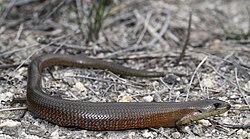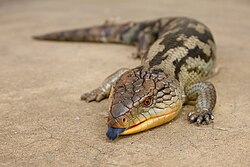| Image | Genus | Species |
|---|
 | Bellatorias
Wells & Wellington, 1984 | |
 | Corucia
Gray, 1855 | |
 | Cyclodomorphus
Fitzinger, 1843 | |
 | Egernia
Gray, 1832 | - Egernia cunninghami (Gray, 1832) – Cunningham's spiny-tailed skink
- Egernia cygnitos Doughty, Kealley & Donnellan, 2011 – Western Pilbara spiny-tailed skink
- Egernia depressa (Günther, 1875) – pygmy spiny-tailed skink
- Egernia douglasi Glauert, 1956 – Kimberley crevice-skink
- Egernia eos Doughty, Kealley & Donnellan, 2011 – central pygmy spiny-tailed skink
- Egernia epsisolus Doughty, Kealley & Donnellan, 2011 – Eastern Pilbara spiny-tailed skink
- Egernia formosa Fry, 1914 – Goldfield's crevice-skink
- Egernia hosmeri Kinghorn, 1955 – Hosmer's spiny-tailed skink
- Egernia kingii (Gray, 1838) – King's skink
- Egernia mcpheei Wells & Wellington, 1984 – eastern crevice-skink, McPhee's egernia
- Egernia napoleonis (Gray, 1838) – southwestern crevice-skink
- Egernia pilbarensis Storr, 1978 – Pilbara crevice-skink
- Egernia richardi (W. Peters, 1869) – bright crevice-skink, dark spiny-tailed skink
- Egernia roomi (Wells & Wellington, 1985)
- Egernia rugosa De Vis, 1888 – Yakka skink
- Egernia saxatilis Cogger, 1960 – Black rock skink, black crevice-skink
- Egernia stokesii (Gray, 1845) – gidgee spiny-tailed skink, gidgee skink, Stokes's skink
- Egernia striolata (W. Peters, 1870) – tree crevice-skink, "tree skink"
|
 | Liopholis
Fitzinger, 1843 | - Liopholis guthega Donnellan, Hutchinson, Dempsey & Osborne, 2002 – Snowy Mountains skink, guthega skink, alpine egernia
- Liopholis inornata (Rosén, 1905) – desert egernia, unadorned desert-skink, "desert skink"
- Liopholis kintorei (Stirling & Zietz, 1893) – Great Desert skink
- Liopholis margaretae (Storr, 1968) – Centralian Ranges rock-skink, Flinder's Ranges rock-skink
- Liopholis modesta (Storr, 1968) – Eastern Ranges rock-skink
- Liopholis montana Donnellan, Hutchinson, Dempsey & Osborne, 2002 – montane rock-skink, mountain egernia, "mountain skink"
- Liopholis multiscutata (Mitchell & Behrndt, 1949) – bull skink, southern sand-skink, heath skink
- Liopholis personata (Storr, 1968)
- Liopholis pulchra (F. Werner, 1910) – southwestern rock-skink, spectacled rock skink, Jurien Bay rock-skink
- Liopholis slateri (Storr, 1968) – Slater's desert skink, Centralian Floodplains desert-skink, Slater's egernia, Slater's skink
- Liopholis striata (Sternfeld, 1919) – night skink, nocturnal desert-skink, striated egernia
- Liopholis whitii (Lacépède, 1804) – White's skink, White's rock-skink
|
 | Lissolepis
W. Peters, 1872 | |
 | Tiliqua
Gray, 1825 | |
 | Tribolonotus
A.M.C. Duméril & Bibron, 1839 | - Tribolonotus annectens Zweifel, 1966 – Zweifel's helmet skink, New Britain spiny skink
- Tribolonotus blanchardi Burt, 1930 – Blanchard's helmet skink
- Tribolonotus brongersmai Cogger, 1973 – Admiralty spiny skink, Brongersma's helmet skink
- Tribolonotus choiseulensis Rittmeyer & Austin, 2017
- Tribolonotus gracilis de Rooij, 1909 – red-eyed crocodile skink, red-eyed bush crocodile skink
- Tribolonotus novaeguineae (Schlegel, 1834) – white-eyed crocodile skink
- Tribolonotus parkeri Rittmeyer & Austin, 2017
- Tribolonotus ponceleti Kinghorn, 1937 – giant spiny skink, Poncelet's helmet skink
- Tribolonotus pseudoponceleti Greer & Parker, 1968 – western crocodile skink, false Poncelet's helmet skink
- Tribolonotus schmidti Burt, 1930 – Schmidt's helmet skink, Schmidt's crocodile skink
|
|








